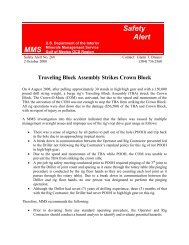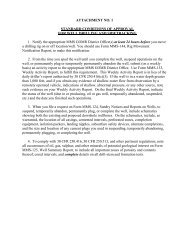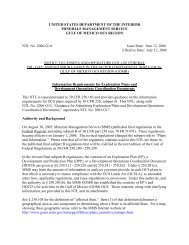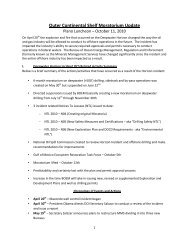Deepwater Gulf of Mexico 2004: America's Expanding ... - OCS BBS
Deepwater Gulf of Mexico 2004: America's Expanding ... - OCS BBS
Deepwater Gulf of Mexico 2004: America's Expanding ... - OCS BBS
- No tags were found...
Create successful ePaper yourself
Turn your PDF publications into a flip-book with our unique Google optimized e-Paper software.
LEASE OWNERSHIP<br />
A handful <strong>of</strong> major oil and gas companies blazed the trail into deepwater in the 1980’s and early 1990’s.<br />
In this report, we define major companies to include BP, ChevronTexaco, ExxonMobil, and Shell.<br />
Appendix E shows the companies and subsidiaries that form these majors. (Grouping <strong>of</strong> these four<br />
entities does not indicate a regulatory conclusion or an analysis <strong>of</strong> production size. It is merely a<br />
convenient category for the purpose <strong>of</strong> comparison.) Figure 27 illustrates the relative leaseholding<br />
positions <strong>of</strong> majors versus nonmajors. (Figure 27 reflects the most recent lease ownerships at the end <strong>of</strong><br />
each 2-year period.) Note that majors dominated deepwater leasing in 1992-1993. In 1996, nonmajors<br />
began acquiring significant leaseholdings, a trend that continued through 2003. Nonmajor companies are<br />
poised to play a leading role in the future <strong>of</strong> the deepwater <strong>Gulf</strong>.<br />
The type <strong>of</strong> companies active in deepwater clearly changed with the increased presence <strong>of</strong> nonmajor oil<br />
and gas companies. Another change in deepwater lease ownership came with the wave <strong>of</strong> company<br />
mega-mergers. The industry mergers increased the diversity <strong>of</strong> leaseholdings for the merged companies.<br />
For example, while some companies were heavily focused on the deepwater GOM prior to the mergers,<br />
their merger partners may have been focused primarily on shallow-water prospects. The combination <strong>of</strong><br />
these entities yielded a larger leasehold position in all water depths and frequently a broader geographic<br />
range across the GOM.<br />
FUTURE LEASE ACTIVITY<br />
Since the deepwater arena is already heavily leased, the number <strong>of</strong> leases that are relinquished or expire<br />
will influence activity in future lease sales. Given the fact that most companies can only drill a small<br />
percentage <strong>of</strong> their active leases, it is likely that many high-quality leases will expire without being tested.<br />
The impending turnover <strong>of</strong> these leases <strong>of</strong>ten results in “farm-outs” to nonmajors, opportunities for<br />
different companies to gain a lease position and, potentially, a more rapid exploration and development <strong>of</strong><br />
the acreage. Ultimately, an untested and undeveloped lease will expire and possibly be leased again.<br />
Figure 28 shows leases that will expire in the coming years, assuming each lease expires at the end <strong>of</strong> its<br />
primary lease term (without a lease-term extension). Note that lease terms vary according to water depth.<br />
Primary lease terms are five years for blocks in less than 400 m (1,312 ft), eight years for blocks in<br />
400-799 m (1,312-2,622 ft), and ten years for blocks in 800 m (2,625 ft) or greater. Therefore, in the<br />
absence <strong>of</strong> primary lease-term extensions, all active shallow-water leases will expire before 2010<br />
(explaining the absence <strong>of</strong> expiring shallow-water leases in certain frames <strong>of</strong> figure 28). The 2003 and<br />
<strong>2004</strong> lease sales will <strong>of</strong>fer a limited number <strong>of</strong> expired deepwater leases because <strong>of</strong> moderate leasing<br />
activity in 1993 and 1994. The availability <strong>of</strong> previously leased blocks is expected to increase<br />
dramatically in 2006 as a result <strong>of</strong> the leasing boom that began in 1996 and continued through 1998. The<br />
lease expiration projections will pressure leaseholders to drill and evaluate their holdings and will provide<br />
opportunities for other companies to enter an active play by acquiring leases as they expire or by<br />
obtaining “farm-outs” from companies with untested acreage.<br />
42







